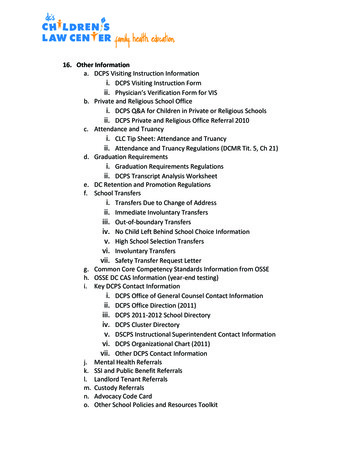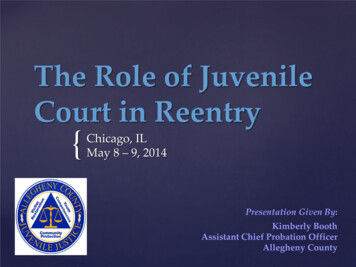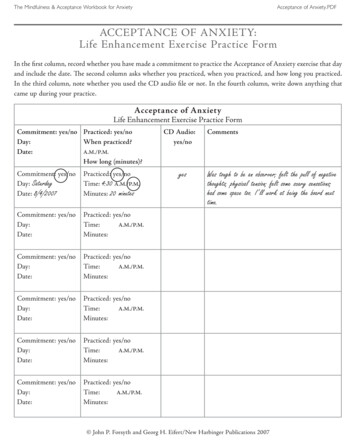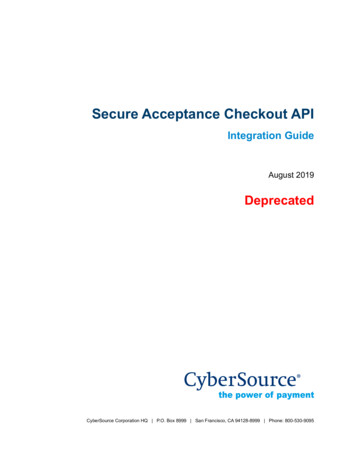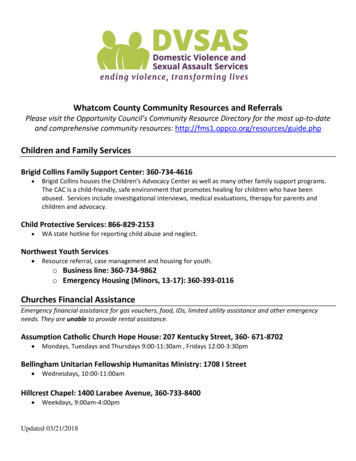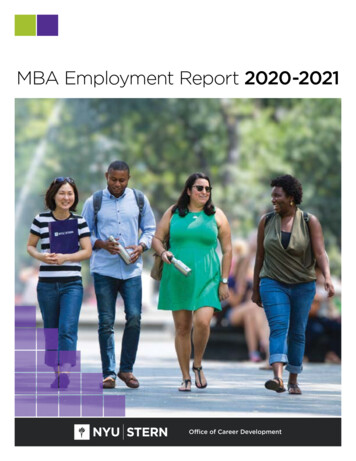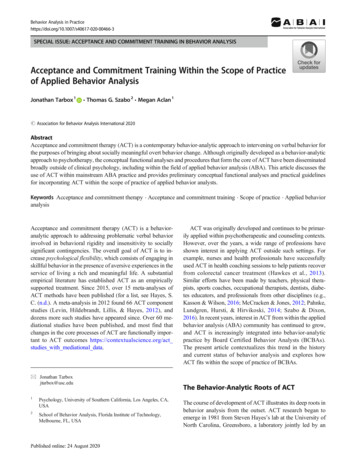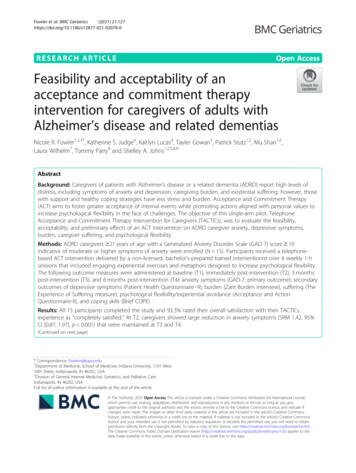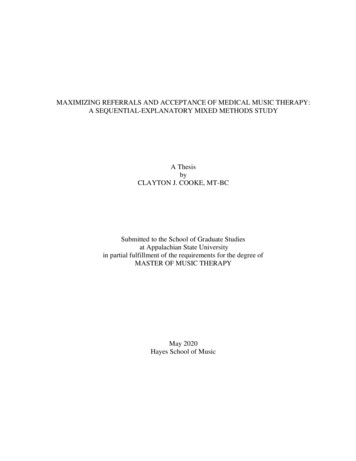
Transcription
MAXIMIZING REFERRALS AND ACCEPTANCE OF MEDICAL MUSIC THERAPY:A SEQUENTIAL-EXPLANATORY MIXED METHODS STUDYA ThesisbyCLAYTON J. COOKE, MT-BCSubmitted to the School of Graduate Studiesat Appalachian State Universityin partial fulfillment of the requirements for the degree ofMASTER OF MUSIC THERAPYMay 2020Hayes School of Music
MAXIMIZING REFERRALS AND ACCEPTANCE OF MEDICAL MUSIC THERAPY:A SEQUENTIAL-EXPLANATORY MIXED METHODS STUDYA ThesisbyCLAYTON J. COOKE, MT-BCMay 2020APPROVED BY:Christine P. Leist, Ph.D., MT-BCChairperson, Thesis CommitteeCathy H. McKinney, Ph.D., MT-BCMember, Thesis CommitteeSusan D. Roggenkamp, Ph.D.Member, Thesis CommitteeJames R. Douthit, D.M.A.Dean, Hayes School of MusicMichael J. McKenzie, Ph.D.Dean, Cratis D. Williams School of Graduate Studies
Copyright by Clayton J. Cooke 2020All Rights Reserved
AbstractMAXIMIZING REFERRALS AND ACCEPTANCE OF MEDICAL MUSIC THERAPY:A SEQUENTIAL-EXPLANATORY MIXED METHODS STUDYClayton J. Cooke, MT-BCB.M., East Carolina UniversityM.M.T., Appalachian State UniversityThesis Committee Chairperson: Christine P. Leist, Ph.D., MT-BCThis study sought to explore music therapists’ experiences of receivingreferrals and acceptance or declination of services in medical settings. Through amixed methods design, this study also elaborates on music therapists’ experienceswith improving referral quantity and quality and increasing acceptance of services inmedical settings. The researcher invited 8,240 music therapists credentialed throughthe Certification Board of Music Therapists (CBMT) to participate in an onlinesurvey constructed by the researcher to provide a baseline for medical musictherapists’ experiences with referrals and service acceptance. Eligibility forparticipation was determined through the survey; the full survey was only accessed byeligible participants or those credentialed music therapists with at least one year ofexperience working in a medical setting (i.e., adult medical hospitals, children’smedical hospitals, or Veterans Health Administration medical centers) within the last10 years. Responses were returned by 512 music therapists, and these responsesincluded 163 from eligible participants. Four survey respondents were selected foriv
participation in individual follow-up interviews lasting about an hour each to furtherdescribe their experiences and to provide suggestions in medical music therapy toimprove referrals and increase acceptance of music therapy services. The researcherintegrated the findings of the online survey and follow-up interviews to explain thecommon experiences of medical music therapist with referrals and service acceptanceand their recommendations for other music therapists practicing in medical settings.Results of this study indicated a number of methods for improving other healthcareprofessionals’, patients’, and families’ understandings of and experiences withmedical music therapy to increase referral quantity and quality and patient acceptanceof services. Findings of this study suggest continued research with these topics inmedical music therapy to assess the requirements of music therapists working inmedical settings and provide medical music therapists with access to tools andinformation for improving their practices.v
AcknowledgmentsI would first like to acknowledge the teachers and mentors that began my career inmusic therapy and guided my interests in medical music therapy, Dr. Michelle Hairston andClaire Littlejohn. Without the dedication of these two music therapists in my education andtraining, I would not have found my own passion as a music therapist. I would also like toacknowledge Dr. Melody Schwantes for her expertise and guidance in research designs thatgreatly influenced the design of this study. Additionally, I would like to acknowledge theOffice of Student Research at Appalachian State University for their generosity to fund theearly stages of this study.I would like to thank the members of my thesis committee, first to Dr. SusanRoggenkamp for her agreement to serve and provide guidance and knowledge through herexpertise in healthcare administration and to Dr. Cathy McKinney for helping to shape myprofessional identity as a music therapist and my beliefs about the field of music therapywhile simultaneously providing guidance and care to my education and well-being. I wouldalso like to express my utmost gratitude, respect, and admiration to Dr. Christine Leist forserving not only as my thesis chairperson, but also for the many roles she played throughoutthe process of my graduate education and thesis study to support and cheer me on whileproblem-solving and paving the way for this study with her extensive knowledge in andcommitment to music therapy. Even when I believed I would never finish, she continued tobelieve in me. I cannot express enough appreciation for her and my thesis committee.vi
Additionally, I would like to thank the participants of this study for their donated timeand knowledge in providing their professional experiences in medical music therapy andencouraging me to completion with their interest and enthusiasm. I am overwhelmed by theresponses I received during this study. I am especially grateful for the four interviewparticipants, who will remain anonymous, for their willingness to assist the continued growthof medical music therapy through shared insight and recommendations. As evidenced by thededication of all participants, I believe medical music therapy is in great shape.Lastly, I would like to thank those who stand by me for loving the person I am andenduring the stress of my graduate school experiences and the quirks I have developed alongthe way. I would not have made it through these experiences without the everlasting supportof my dear friends Katy, Riley, and Alyssa and the many wonderful friends I have met inBoone. I will forever be thankful to my sister Madison for constantly providing me with thecomic relief I needed throughout every day of the past two years. Finally, I would like toexpress the most love and adoration for my parents Stephen and Angie for theirunconditional love and support, especially through the times I did not feel like I deserved it.Without them, nothing in my life would be possible.vii
Table of ContentsAbstract . ivAcknowledgments. viList of Tables . ixList of Figures .xChapter 1: Introduction .1Chapter 2: Literature Review .14Chapter 3: Method .37Chapter 4: Survey Results .52Chapter 5: Interview Results .78Chapter 6: Discussion .125References .145Appendices .157Vita .174viii
List of TablesTable 1. Other Degrees, Licensures, Certificates, or Trainings by Respondents .54Table 2. Other Healthcare Facilities .55Table 3. Referral Sources in Medical Music Therapy .57Table 4. Top-Ranked Music Therapy Referral Sources .58Table 5. Lowest-Ranked Music Therapy Referral Sources .59Table 6. Frequency of Music Therapy Referral Reasons .60Table 7. Inappropriate Referrals for Music Therapy in Medical Settings .61Table 8. Sources of Inappropriate Medical Music Therapy Referrals .62Table 9. Staff Education Techniques for Medical Music Therapy .63Table 10. Recipients of Education About Medical Music Therapy .64Table 11. Misrepresentation of Medical Music Therapy .65Table 12. Other Reasons for Declination of Music Therapy Services in Medical Settings .67Table 13. Approaches to Increase Acceptance of Medical Music Therapy Services .68Table 14. Approaches to Decrease Acceptance of Medical Music Therapy Services .70Table 15. Perceptions of Relationship Between Music Therapy Education and ServiceAcceptance .71Table 16. Additional Topics of Interest Expressed by Respondents .72Table 17. Themes From the Interview Data Categorized by Content Area.79Table 18. Interview Participant Demographics .81ix
List of FiguresFigure 1. Participant Flow.44Figure 2. Flow of the Study .46x
1Chapter 1: IntroductionAs a relatively new professional field of work, music therapy in the United Stateslends itself to doubt, misrepresentation, misunderstanding, and devaluation by other, moreestablished healthcare professionals. Although the healing influence of music to affect healthand behavior can be traced back as early as the writings of Plato, the 20th Century musictherapy profession is said to have been formally established after World War II by bothprofessional and community musicians who served veterans hospitals around the country,bringing music “therapy” to the thousands of veterans experiencing physical and emotionaltrauma from the wars. After the recognition for training and demand for academicpreparation became evident, Michigan State University established the first academicprogram in music therapy in 1944 (AMTA, 2020b; Gfeller & Davis, 2008a).Shortly after the creation of the first training programs, the National Association forMusic Therapy (NAMT) was founded in 1950 in order to provide a more formal organizationto promote and further the development of music therapy (AMTA, 2020b; Moore, 2015).One of the most significant contributions to the field of music therapy by the NAMT was thecreation of the Registered Music Therapist (RMT) designation in order to provide a measureof quality assurance—the first professional standard for music therapy upon which theprofession could advocate—to employers and patients of music therapists (Moore, 2015).In 1971, the American Association for Music Therapy (AAMT)—originally calledthe Urban Federation for Music Therapists (UFMT)—was formed with similar interests as
2the NAMT. Both organizations, the NAMT and the AAMT, heavily encouraged research inmusic therapy, still furthering grounds for advocacy and developing evidence-based practicesfor the field (AMTA, 2020b; Gfeller & Davis, 2008a; Moore, 2015).The Certification Board for Music Therapists (CBMT) was established in 1983 as athird organization with a responsibility for creating and maintaining a certification programfor music therapists. Associated with both the NAMT and the AAMT, the CBMT requiredcontinuing education and enforced a level of rigor and accountability to support continuedadvocacy efforts in music therapy (AMTA, 2020b; Moore, 2015). In 1998, the NAMT andthe AAMT merged as a unified organization to form the American Music TherapyAssociation (AMTA, 2020b; Gfeller & Davis, 2008a; Moore, 2015).Since the conception of the NAMT in 1950, music therapists have been focusingefforts on advancing music therapy practices and advocacy. With only 76 years since theestablishment of the first training program in the United States, music therapy is stillrelatively new when compared to other healthcare professions. In order for music therapiststo maximize patient access to music therapy, appropriate referrals to services must increase.Today, many healthcare professionals may not be aware of music therapy, how it isimplemented, and how it can benefit patients, limiting referrals to services. With educationand advocacy efforts however, the profession is continuing to earn the needed recognitionand support of legislators and other healthcare professionals, increasing access to musictherapy services for the patients who benefit.
3Definition of TermsMusic TherapyThe AMTA (2015) defined music therapy is defined as “the clinical and evidencebased use of music interventions to accomplish individualized goals for people of all agesand ability levels within a therapeutic relationship” (para. 3) by a board-certified musictherapist. The AMTA (2020a; 2020e) further described music therapy as an established alliedhealth profession to address individual, group, family, or community quality of life andimprove physical, emotional, cognitive, communicative, spiritual, sensory, and social needs.The involvement in music actively (i.e., by making music) and receptively (i.e., by listeningto music) within a therapeutic context strengthens clients’ abilities which are transferred toother areas of their lives. Music therapy is effective in “increasing people’s motivation tobecome engaged in their treatment, providing emotional support for clients and their families,and providing an outlet for expression of feelings” (AMTA, 2020a, para. 2). According to theWorld Federation of Music Therapy (WFMT, 2011), music therapy research, practice,education, and clinical training are based on professional standards according to cultural,social, and political contexts.Medical Music Therapy. Bruscia (2014) defined medical music therapy as thefollowing:All applications of music and music therapy that provide direct treatment of themedical condition and its symptoms; various kinds of support that may be neededduring medical tests, surgery, or procedures; and therapeutic processes that addressthe emotional, interpersonal, social, spiritual, and ecological needs of the client andfamily (p. 216).
4Ghetti (2013) also provided a definition for music therapy as procedural support to describepediatric medical music therapy: “pediatric medical music therapy is the use of music and thetherapeutic relationship to promote healthy coping and safeguard the child’s psychosocialwellbeing during inpatient and outpatient medical treatment” (p. 4). Music therapists inmedical settings provide services to populations with a variety of diagnoses across thelifespan in both inpatient and outpatient healthcare facilities. As a result, patients may receivemusic therapy in a variety of units including (but not limited to) (a) intensive care, (b)intermediate care, (c) rehabilitation, (d) radiology, (e) oncology, (f) palliative care, (g)neonatal intensive care, (h) pediatrics, (i) medical and surgical care, (j) older adults, (k)emergency department, (l) end-of-life care, (m) psychosocial care, (n) cardiology, and (o)neurology (Allen, 2013; DeLoach, 2018; Shultis & Gallagher, 2014).Board-Certified Music TherapistAccording to the AMTA and the CBMT, a board-certified music therapist is anindividual who has “completed the education and clinical training requirements establishedby the American Music Therapy Association (AMTA), holds current board certificationfrom The Certification Board for Music Therapists (CBMT)” (AMTA, 2015, para. 3) and has“demonstrated the knowledge, skills and abilities necessary to practice music therapy at thecurrent level of the profession” (CBMT, 2019b, para. 1). Board-certified music therapistsmust have at minimum a bachelor’s degree or its equivalent in music therapy. Graduate anddoctoral programs are also available in music therapy. There are currently 84 schools in theUnited States that offer coursework toward board certification and advanced degrees inmusic therapy that meet the requirements of the AMTA (AMTA, 2020c). Required educationand training includes coursework in social sciences, life sciences, music foundations, clinical
5foundations, and music therapy practice as well as 1,200 hours of supervised clinical training(AMTA, 2013b). Additionally, continuing education requirements must be met to maintainthe credential and currency of music therapy practices (CBMT, 2019a).The AMTA (2020d) further described the personal qualifications that the ideal musictherapist must possess:Personal Qualifications of a Music Therapist include a genuine interest in people anda desire to help others empower themselves. The essence of music therapy practiceinvolves establishing caring and professional relationships with people of all ages andabilities. Empathy, patience, creativity, imagination, an openness to new ideas, andunderstanding of oneself are also important attributes. Because music therapists aremusicians as well as therapists, a background in and love of music are also essential.(para. 3)Music may be used therapeutically in medical settings by other types of musicians:(a) music practitioners, (b) harp therapists, (c) music and sound healers, (d) clinicalmusicians, and (e) music thanatologists (Allen, 2013; AMTA, 2004). Additionally, clinicalstaff other than music therapists may use music to enhance their interventions (e.g., a nursesinging a song about a bee while administering a flu shot to a child afraid of needles).However, music therapy differs from these approaches by fostering a therapeuticrelationship, working through music interactions, being an active element of the treatmentplan, developing individualized goals for specific outcomes, and requiring a board-certifiedmusic therapist (Music Therapy Hub, 2019). While many music therapists agree that moremusic in healthcare can be positive for patients, it is also agreed that the education andtraining necessary to become board-certified protects patients from potentially harmful
6interactions with music. As such, the following uses of music to enhance healthcare whilebeneficial, are not within in the definition of clinical music therapy: an individual in anursing home listening to music from his young adulthood on an iPod; an individual playingmusic for a patient in the hospital; medical staff playing music in the background for patients;and other groups of musicians who may use music therapeutically (AMTA, 2020a).According to the Standards of Clinical Practice (AMTA, 2013a), music therapists arequalified to provide referrals, determine appropriateness of referrals, administer assessments,plan treatments, implement interventions, perform documentation, and determine appropriatetermination of services for a variety of client populations. The client populations outlined bythe Standards of Clinical Practice include (a) addictive disorders, (b) consultative services,(c) intellectual and developmental disabilities, (d) education, (e) older adults, (f) medicalhealth, (g) mental health, (h) physical disabilities, (i) private practice, and (j) wellnesssettings.Other Healthcare ProfessionalsWhere stated, the term “other healthcare professionals” includes any medical,nursing, or allied health staff music therapists interact with in medical settings. Theseprofessionals may include, but are not limited to, (a) administrators, (b) physicians, (c)nurses, (d) nursing assistants, (e) physical therapists, (f) occupational therapists, (g)respiratory therapists, (h) speech and language pathologists, (i) social workers, (j) medicationtechnicians, (k) psychologists, (l) child life specialists, (m) other creative arts therapists, (n)chaplains, and (o) other members of the interdisciplinary team. In the context of this paper,this term specifically refers to any professional working outside the field or scope of musictherapy or those who have not specifically received the education, training, and certification
7as outlined by both the AMTA and CBMT. Additionally, the professionals included in thesecriteria may have little or no education or exposure to the practice of music therapy, therebypossibly having inaccurate views, misperceptions, or misguided attitudes about the practice.Interdisciplinary Team. In healthcare, an interdisciplinary team is a group ofhealthcare professionals consisting of medical, nursing, and allied health professionals fromdifferent disciplines who work toward the same goal in order to provide the best outcome fora patient or group of patients (Saunders, n.d.). Together, an interdisciplinary team decides ona plan of care for a patient, including the direction and anticipated outcomes of interventions.In their own discipline or during cotreatment and procedural support, professionals utilizetheir expertise and scope of practice to provide opportunities for patient changes toward thelikely outcomes and anticipated results of treatment.Cotreatment. According to North Shore Pediatric Therapy (2020), cotreatmentsessions “are when two therapists from different disciplines (Speech Therapy (SLP),Occupational Therapy (OT), Physical Therapy (PT), etc.) work together with [a patient] tomaximize therapeutic goals and progress” (para. 2). This occurs when two disciplines sharecomplimentary or similar goals as determined by the interdisciplinary team. The JointGuidelines for Therapy Cotreatment under Medicare stated that cotreatment is appropriatewhen “practitioners from different professional disciplines can effectively address theirtreatment goals while the patient is engaged in a single therapy session” (The AmericanSpeech–Language–Hearing Association, The American Occupational Therapy Association,& The American Physical Therapy Association, n.d., para. 1). Some benefits of cotreatinginclude cohesive treatment plans that work toward goals in a shorter period of time,encouraging participation and good behavior, collaboration and discussion of the treatment
8plan, generalization of skills to other contexts, and assistance in immediate problem solving(North Shore Pediatric Therapy, 2020).Procedural Support. Child life specialists define procedural support as “supportduring medical procedures” (p. 131). Gaynard et al. (1990) described procedural support inpediatrics as an intervention involving remaining with a child (when appropriate) during amedical procedure in order to provide support and offer effective coping behaviors. Musictherapists may provide procedural support for physicians and nurses during medicalprocedures (e.g., a blood draw) in order to integrate or distract the patient duringunpleasurable experiences and provide coping tools for patients in future procedures.Music Therapy AdvocacyAdvocacy is defined as “the act or process of supporting a cause or proposal”(Merriam–Webster, n.d.). As members of a relatively new allied health profession, musictherapists are charged with safeguarding their profession from those who unintentionallymisrepresent the field (i.e., those without the proper education, training, and credential topractice music therapy but misname their work as music therapy) and those who are unawareof its efficacy of treatment. In healthcare, music therapists advocate on many levels amongother healthcare professionals and the patients being served by the healthcare facility (Moore,2015). Advocacy may occur on small-scale levels or in individual interactions such as when amusic therapist speaks to a patient about music therapy services or explains the significanceof music therapy work to another healthcare professional; advocacy may also occur on largescale levels such as when a music therapist provides an in-service for the staff of a particularhospital unit (Moore, 2015) or presents at a conference of members of another profession.
9Medical HospitalsFor the purposes of this study, a medical hospital is defined as inpatient andoutpatient institutions providing medical care, surgical care, and therapeutic services to sickor injured patients under the supervision that are typically not available in places of residence(Marcovitch, 2018; Merriam–Webster, n.d.). The National Database of Nursing QualityIndicators as cited by Dunton et al. (2008) defined a hospital as an institution providingdiagnostic and therapeutic services for “medical diagnoses, treatment, and care of injured,disabled, or sick persons” as well as “rehabilitation services for injured, disabled, or sickpersons” by or under the supervision of physicians (p. 19). The Centers for Medicare &Medicaid Services as cited by Reigart and Posek (2019) defined a hospital as a facility that is“primarily engaged in the provision of inpatient care” (p. 55) and defined inpatient care asrequiring medical services “that will span two midnights or more” (p. 59). This study willfocus on three types of medical hospitals providing music therapy services: general medicalhospitals, children’s medical hospitals, and Veterans Health Administration medical centers.General Medical Hospitals. The World Health Organization (2019) describedhospitals as important structures in health care systems ashealth care institutions that have an organized medical and other professional staff,and inpatient facilities, and deliver medical, nursing and related services 24 hours perday, 7 days per week. Hospitals offer a varying range of acute, convalescent andterminal care using diagnostic and curative services in response to acute and chronicconditions arising from diseases as well as injuries and genetic anomalies. In doing sothey generate essential information for research, education and management.Traditionally oriented on individual care, hospitals are increasingly forging closer
10links with other parts of the health sector and communities in an effort to optimize theuse of resources for the promotion and protection of individual and collective healthstatus. (para. 1–3)For the purposes of this study, a general medical hospital is described as a medical facilitytreating an array of medical conditions for patients of all age groups.Children’s Medical Hospitals. The Children’s Hospital Association (CHA; 2020)describes children’s hospitals as medical facilities specifically designed to meet the uniqueneeds of children delivered by specialized clinicians in specialized environments. CHA(2020) stated that “children’s hospitals serve all kids children’s hospitals serve kids at eachstage of growth and development, requiring differently sized equipment and a range ofexpertise” (para. 6).Veterans Health Administration Medical Centers. The U.S. Department ofVeterans Affairs described the Veterans Health Administration (VHA) as the largestintegrated health care system in the United States consisting of Veterans Affairs medicalfacilities across the country (2019). VHA medical centers provide medical and surgicalservices to United States military veterans such as surgery, critical care, mental health,orthopedics, pharmacy, radiology, and physical therapy (U.S. Department of Veterans Affairs,2019).
11Treatment Process in Medical Music TherapyMusic therapists follow a step-by-step method for approaching patients with servicesand facilitating the processes that subsequently occur (Borczon, 2017). The generalguidelines for the treatment process include a referral to music therapy services, assessmentand identification of goals and objectives, treatment planning and implementation, evaluationand documentation, and termination of treatment (Borczon, 2017; Gfeller & Davis, 2008b;Hanser, 2018; Wheeler, 2014; Yinger, 2018).Music Therapy Referrals, Consults, and Orders. Receiving a referral, consult, ororder to provide music therapy services in healthcare is the initial step toward making contactwith patients and are a necessary step in providing and documenting appropriate andeffective clinical work (Gfeller & Davis, 2008b). Referrals help music therapists to identifypatients who are in the greatest need of music therapy services (Loewy, 2014) by giving abrief look at the client through information such as age, sex, diagnoses, medications, andother relevant information (Borczon, 2017). Once a referral for music therapy has been made,a presenting problem has been identified and is translated into music therapy goals andobjectives that align with the overall treatment plan (Hanser, 2018).Borczon (2017) stated that referrals may be made by a variety of professionals inclinical settings, most commonly from (a) physicians, (b) social workers, (c) psychologists,(d) teachers, (e) occupational therapists, (f) recreational therapists, (g) speech and languagepathologists, (h) physical therapists, (i) art therapists, (j) counselors, or (k) any otherprofessional that may provide treatment referrals; referrals for music
program in music therapy in 1944 (AMTA, 2020b; Gfeller & Davis, 2008a). Shortly after the creation of the first training programs, the National Association for Music Therapy (NAMT) was founded in 1950 in order to provide a more formal organization to promote and further the development of music therapy (AMTA, 2020b; Moore, 2015).



